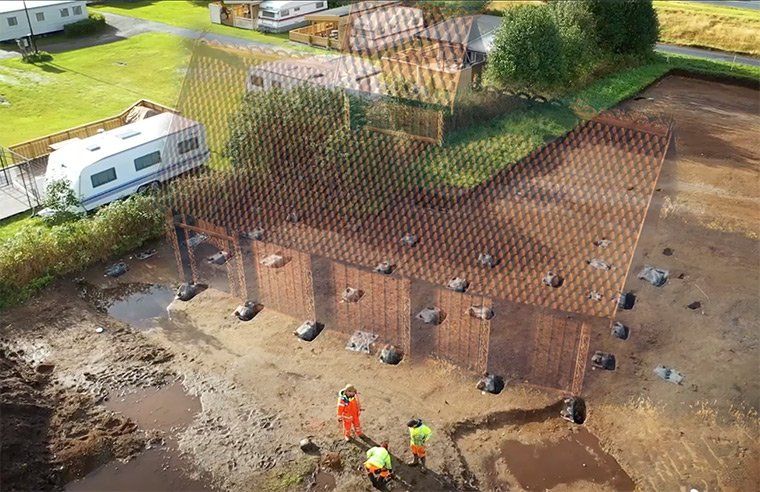Ruins of Eighth-Century Pagan Temple Found in Norway
The structure—built to honor Norse gods like Thor and Odin—is the first of its kind discovered in the country
:focal(536x378:537x379)/https://tf-cmsv2-smithsonianmag-media.s3.amazonaws.com/filer/eb/a8/eba8fa1a-2d7c-41ae-9a35-1e2bf16b87cc/godhouse.jpg)
Archaeologists from Norway’s University Museum of Bergen have unearthed the remains of an eighth-century “godhouse,” or temple dedicated to the gods of the Norse pantheon, in the village of Ose.
The researchers discovered the structure’s ruins while conducting excavations ahead of construction of a housing development. Based on the placement of postholes and other artifacts, they were able to determine how the godhouse would have looked in its prime.
As Sissel Beate Brunstad and Olaug Bjørneset report for Norwegian broadcaster NRK, the building’s layout is almost identical to late Iron Age godhouses found at Uppåkra in southern Sweden and Tissø in Denmark. But this is the first temple of its kind identified in Norway.
“We have discovered the most perfectly shaped godhouse of all the finds so far—I know of no other Scandinavian buildings in which the house construction is as clear as it is here,” Bergen University Museum architect Søren Diinhoff, who helped lead the excavation, tells Syfy Wire’s Elizabeth Rayne. “I think our building is central to document and verify this very special architecture.”
Per a statement, the temple was about 45 feet long and 23 to 26 feet wide. It stood up to 40 feet tall.
Worshippers probably used the godhouse for midsummer and midwinter solstice ceremonies, reports Matthew Taub for Atlas Obscura. A large “phallus stone” found at the site in 1928 supports this theory, offering an overt invocation of fertility.
The latest round of excavations has recovered cooking pits and animal bones—remnants of meats prepared for figurines representing Odin, Thor, Freyr and other Norse gods. The figures themselves have been lost over time.

Live Science’s Tom Metcalfe writes that since the gods were only able to consume the food in spirit, religious services also doubled as feasts for worshippers.
“You would have a good mood, a lot of eating and a lot of drinking,” Diinhoff tells Live Science. “I think they would have had a good time.”
According to Atlas Obscura, worshippers of the Norse gods began building such structures in the sixth century, when they first encountered southern European societies that boasted large Christian churches. The godhouses incorporated architectural elements used in Christian buildings, such as pitched roofs with towers. Their grand architecture also reflected an increasingly class-stratified society, in which a growing wealthy elite may have organized major building projects to project social and economic power.
For centuries before Norse societies came into contact with Christian communities, worship of the old gods took place at more modest locations. In fact, signs of religious activity at the Ose site date back to the fifth or sixth century. The cooking pits predate the godhouse itself, likely reflecting worship before construction of the church-like structure. Two older longhouse structures used to keep livestock also stand on the site. One contains a circular area associated with religious rites.
Atlas Obscura notes that the presence of both types of worship sites may reflect a single family’s rise in social status over time. If so, the family’s property likely become increasingly central to religious activities in the community.
Starting in the 11th century, when Christianity became the dominant religion in Norway, kings burned or demolished the buildings of the Old Norse religion. But researchers are unsure whether this was the fate of the godhouse at Ose.
“It would be ideal if we could explain that,” Diinhoff tells Live Science. “But we’re not there yet.”
/https://tf-cmsv2-smithsonianmag-media.s3.amazonaws.com/accounts/headshot/Livia_lg_thumbnail.png)
/https://tf-cmsv2-smithsonianmag-media.s3.amazonaws.com/accounts/headshot/Livia_lg_thumbnail.png)